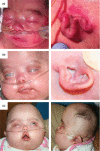TASP1 mutation in a female with craniofacial anomalies, anterior segment dysgenesis, congenital immunodeficiency and macrocytic anemia
- PMID: 31350873
- PMCID: PMC6732342
- DOI: 10.1002/mgg3.818
TASP1 mutation in a female with craniofacial anomalies, anterior segment dysgenesis, congenital immunodeficiency and macrocytic anemia
Abstract
Background: Threonine Aspartase 1 (Taspase 1) is a highly conserved site-specific protease whose substrates are broad-acting nuclear transcription factors that govern diverse biological programs, such as organogenesis, oncogenesis, and tumor progression. To date, no single base pair mutations in Taspase 1 have been implicated in human disease.
Methods: A female infant with a new pattern of diagnostic abnormalities was identified, including severe craniofacial anomalies, anterior and posterior segment dysgenesis, immunodeficiency, and macrocytic anemia. Trio-based whole exome sequencing was performed to identify disease-causing variants.
Results: Whole exome sequencing revealed a normal female karyotype (46,XX) without increased regions of homozygosity. The proband was heterozygous for a de novo missense variant, c.1027G>A predicting p.(Val343Met), in the TASP1 gene (NM_017714.2). This variant has not been observed in population databases and is predicted to be deleterious.
Conclusion: One human patient has been reported previously with a large TASP1 deletion and substantial evidence exists regarding the role of several known Taspase 1 substrates in human craniofacial and hematopoietic disorders. Moreover, Taspase 1 deficiency in mice results in craniofacial, ophthalmological and structural brain defects. Taken together, there exists substantial evidence to conclude that the TASP1 variant, p.(Val343Met), is pathogenic in this patient.
Keywords: Taspase 1; anterior segment dysgenesis; congenital immunodeficiency; craniofacial anomaly; macrocytic anemia.
© 2019 The Authors. Molecular Genetics & Genomic Medicine published by Wiley Periodicals, Inc.
Conflict of interest statement
None declared.
Figures




References
Publication types
MeSH terms
Substances
Supplementary concepts
Grants and funding
LinkOut - more resources
Full Text Sources
Medical

